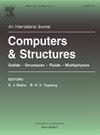An efficient method for estimating building dynamic response due to train operations in tunnel considering transmission path from source to receiver
IF 4.4
2区 工程技术
Q1 COMPUTER SCIENCE, INTERDISCIPLINARY APPLICATIONS
引用次数: 0
Abstract
The paper presents an efficient method for estimating the dynamic response of buildings due to train operations in tunnel. The proposed method involves four models to consider the transmission path in the train-track-tunnel-soil-pile-building chain: the vehicle model, track-tunnel-soil model, building model, and soil-structure interaction model. A series of theoretical methods are employed, including the multibody dynamic method for wheel-rail interaction, the double Euler-Bernoulli beam method for track structures, the wave decomposition method and transfer matrix method for vibration propagation in soil, the impedance method for building vibration transmission. Validation is conducted through measurements of train-induced ground-borne vibrations and building vibrations in Guangzhou, China. The estimated vibrations demonstrated good agreement with measured vibrations, indicating the feasibility of the proposed method. Parametric studies are subsequently conducted to investigate the influence of spatial relationships between tunnel and pile on building vibrations. The presence of piles results in dissipation and attenuation of vibration energy due to the kinematic interaction. The spatial distribution of the wave field within the soil can significantly impact the coupling loss between the soil and structure. The research findings facilitate a clear comprehension of vibration transmission mechanisms from source to receiver, which are readily applicable in engineering practice for engineers.
考虑到从源头到接收器的传输路径,估算隧道内列车运行引起的建筑物动态响应的有效方法
本文提出了一种估算隧道内列车运行对建筑物动态响应的有效方法。所提出的方法涉及四个模型,以考虑火车-轨道-隧道-土壤-桩基-建筑物链中的传递路径:车辆模型、轨道-隧道-土壤模型、建筑物模型和土壤-结构相互作用模型。采用了一系列理论方法,包括轮轨相互作用的多体动力学方法、轨道结构的双欧拉-伯努利梁法、土壤振动传播的波分解法和传递矩阵法、建筑物振动传播的阻抗法。通过在中国广州测量列车引起的地面振动和建筑物振动进行了验证。估算的振动值与测量的振动值显示出良好的一致性,表明了所提方法的可行性。随后进行了参数研究,以探讨隧道和桩基之间的空间关系对建筑物振动的影响。由于运动相互作用,桩的存在会导致振动能量的耗散和衰减。土壤中波场的空间分布会对土壤和结构之间的耦合损失产生重大影响。这些研究成果有助于清楚地理解从振动源到振动接收器的振动传播机制,便于工程师在工程实践中应用。
本文章由计算机程序翻译,如有差异,请以英文原文为准。
求助全文
约1分钟内获得全文
求助全文
来源期刊

Computers & Structures
工程技术-工程:土木
CiteScore
8.80
自引率
6.40%
发文量
122
审稿时长
33 days
期刊介绍:
Computers & Structures publishes advances in the development and use of computational methods for the solution of problems in engineering and the sciences. The range of appropriate contributions is wide, and includes papers on establishing appropriate mathematical models and their numerical solution in all areas of mechanics. The journal also includes articles that present a substantial review of a field in the topics of the journal.
 求助内容:
求助内容: 应助结果提醒方式:
应助结果提醒方式:


